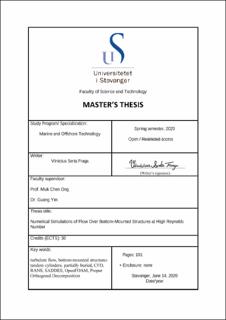| dc.contributor.advisor | Ong, Muk Chen | |
| dc.contributor.advisor | Yin, Guang | |
| dc.contributor.author | Serta Fraga, Vinicius | |
| dc.date.accessioned | 2020-09-18T12:55:12Z | |
| dc.date.available | 2020-09-18T12:55:12Z | |
| dc.date.issued | 2019-06 | |
| dc.identifier.uri | https://hdl.handle.net/11250/2678531 | |
| dc.description | Master's thesis in Marine and Offshore Technology. | en_US |
| dc.description.abstract | A common challenge in on-bottom stability design is to select accurate hydrodynamic quantities, such as drag and lift coefficients, to compute the forces on structures subject to fluid flow. The objective of the present study is to perform series of numerical simulations of flow over different bottom-mounted structures at high Reynolds numbers. The effects of the geometries and configurations of the structures on the hydrodynamic quantities and the surrounding flow fields are investigated.
The thesis is divided into six chapters. The first chapter consists of an introduction of the topics to be investigated. In the second chapter, a brief review of theory of flow around bluff bodies, turbulence and boundary layer flow is given. The third chapter contains the main theory of Computational Fluid Dynamics (CFD). Also, a description of the Proper Orthogonal Decomposition (POD) technique, which is used to perform post-processing of the simulation results, is presented. The following two chapters consist of two submitted draft journal papers.
In the study of the first paper, flows over single and two tandem partially buried cylinders at Reynolds number of 1.31×10^4 are investigated using two-dimensional (2D) Reynolds-averaged Navier-Stokes (RANS) simulations. The cylinders are subjected to a boundary layer flow. The effects of different burial ratios of the cylinders into the bottom wall and the spacings between the two tandem cylinders are studied. The RANS simulations are combined with the k-ω Shear Stress Transport (SST) turbulence model. Due to the bottom-wall, the large-scale vortex shedding behind the cylinders is supressed, hence, steady simulations are performed. Grid resolution studies are conducted, and the validation studies show that the present results are in agreement with previous published data. It is found that the drag and lift coefficients decrease with the increasing burial ratio of the cylinders. For the two tandem cylinders cases, the hydrodynamic forces of the downstream cylinder are significantly lower compared with those of the upstream cylinder. Also, for each burial ratio considered in the present study, a critical distance between the cylinders is found where the drag forces on the downstream cylinder are zero. It is observed that this critical distance is close to the recirculation length behind a single cylinder with the same burial ratio.
In the study of the second paper, flows over bottom-mounted ribs with square, trapezoidal and rectangular cross-sections are studied. Three-dimensional (3D) Spalart-Allmaras Delayed Detached-Eddy Simulations (SADDES) are performed at the Reynolds number of 1×10^6. The
structures are exposed to a boundary layer flow. A grid convergence study is conducted, and the results are validated against the published experimental data. It is observed that the hydrodynamic quantities of the trapezoidal rib are lower compared with those of the square and rectangular ribs. The coherent structures of the turbulent flow are studied using POD analysis of the pressure and velocity components obtained on one streamwise plane and two spanwise planes in the wake region behind the ribs. A convergence study based on the number of snapshots and the time step between them is performed. It is found that the energy is highly concentrated in a few low order modes, which can be useful for building reduced order models of the flow. Many of the POD modes appear in pairs, which indicates the convection of the flow structures. The most energetic flow structures of the POD modes tend to appear around the shear layer of the wake flow and the vortical structures shown in the POD modes indicate a strong 3D behaviour of the flow behind the ribs.
At the end, the main conclusions are given together with the recommendations for future works. | en_US |
| dc.language.iso | eng | en_US |
| dc.publisher | University of Stavanger, Norway | en_US |
| dc.relation.ispartofseries | Masteroppgave/UIS-TN-IMBM/2020; | |
| dc.rights | Navngivelse 4.0 Internasjonal | * |
| dc.rights.uri | http://creativecommons.org/licenses/by/4.0/deed.no | * |
| dc.subject | turbulent flow | en_US |
| dc.subject | bottom-mounted structures | en_US |
| dc.subject | tandem cylinders | en_US |
| dc.subject | partially buried | en_US |
| dc.subject | CFD | en_US |
| dc.subject | RANS | en_US |
| dc.subject | SADDES | en_US |
| dc.subject | OpenFOAM | en_US |
| dc.subject | Proper Orthogonal Decomposition | en_US |
| dc.subject | undervannsteknologi | en_US |
| dc.subject | offshore teknologi | en_US |
| dc.title | Numerical Simulations of Flow Over Bottom-Mounted Structures at High Reynolds Number | en_US |
| dc.type | Master thesis | en_US |
| dc.subject.nsi | VDP::Teknologi: 500::Marin teknologi: 580::Offshoreteknologi: 581 | en_US |

